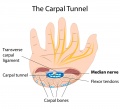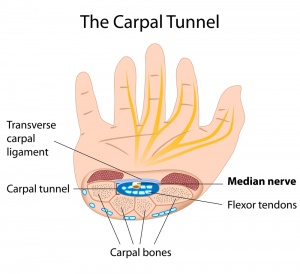Carpal Tunnel Syndrome
Carpal tunnel syndrome is a common ailment that is estimated to affect 3 to 6% of the adult population. There are numerous causes and underlying conditions that increase the risk of carpal tunnel syndrome. Carpal tunnel is especially common in individuals performing repetitive hand maneuvers such as typing.[1]
|
Carpal Tunnel Syndrome | |
| Causes | Repetitive Injuries, Dehydration, Occupations |
|---|---|
| See Also | Musculoskeletal Conditions, Hypothyroidism, Gout, Rheumatoid Arthritis |
| Books | Books on Muscle, Joint and Bone Conditions |
| Articles | Articles on Musculoskeletal Conditions |
Contents
Naturopathic Assessment
Causal Factors
In order to stimulate the innate ability of the body to heal the causes of disease must be identified and addressed. With carpal tunnel, the causes are variable and include posture, repetitive strain, and other underlying conditions. A detailed assessment is needed to identify external factors and behaviors that may contribute to the development and progression of carpal tunnel syndrome.
Lifestyle
- Chronic dehydration may increase the risk of carpal tunnel syndrome.
- Body Mass
- Individuals with increased body mass may be at increased risk of carpal tunnel.[1]
Medical Interventions
- Pharmaceutical Use
- The use of pharmaceuticals including corticosteroids and estrogens has been associated with carpal tunnel syndrome.[2]
External
- Occupation
- Occupations with increased rates of carpal tunnel include food processing, manufacturing, logging, construction work, poultry work, and work involving the use of vibrating tools.[3]
- Trauma
- Acute trauma including fractures, may reduce space in the carpal tunnel and lead to carpal tunnel syndrome.[4]
Diagnostic Testing
Carpal tunnel is frequently tested for clinically with Phalen’s test, Tinel sign, or a median nerve compression tests. These tests vary in specificity and sensitivity, but if all tests are negative the likelihood of carpal tunnel syndrome is very low. Diagnostic studies to confirm and evaluate carpal tunnel syndrome include:[5]
- Imaging Studies
- Imaging studies including high resolution ultrasound, MRI, and roentgenograms may be useful in confirming carpal tunnel syndrome and ruling out other conditions.
- Electrodiagnostic Studies
- Nerve conduction tests are able to identify deficits in nerve conduction in the carpal tunnel and can confirm carpal tunnel syndrome.
Related Symptoms and Conditions
Carpal tunnel syndrome is often associated with the following conditions:[4]
- Myxedema from Hypothyroidism
- Amyloidosis
- Gout
- Acromegaly
- Rheumatoid arthritis
- Tuberculosis
- Pregnancy
Characteristics
- Carpal tunnel syndrome is characterized by pain and/or change in sensation and motor function in the first three fingers of the hand due to compression of the median nerve. The median nerve passes through the carpal tunnel which is composed of the bones of the wrist and the flexor retinaculum. The carpal tunnel can be compressed by inflammation, trauma, or abnormal anatomy.[6]
- Muscle tension contributing to carpal tunnel syndrome may occur at the wrist, elbow, shoulder or in the area of the scapula.
Common symptoms indicating carpal tunnel syndrome include:[7]
- Paresthesia in medial thumb, index, middle, and ring finger
- Sensory loss in medial thumb, index, middle, and ring finger
- Thenar wasting
- Pain relief by hand shaking
- Symptoms worsened during sleep
- Difficulty grasping
Naturopathic Treatment
The goal of naturopathic treatment is to support and work in tandem with the healing power of the body and to address the causal factors of disease with individual treatment strategies. Carpal tunnel syndrome is typically a chronic issue and needs ongoing treatment and modification of risk factors.
It is always advisable to work with a naturopathic doctor before engaging in any treatment plan.
Lifestyle
Lifestyle recommendations include:
Naturopathic Therapies
Naturopathic Therapies for carpal tunnel syndrome include:
- Clinical Nutritional Supplementation including:[6]
- Vitamins including: Vitamin B6
- Other supplements including: Omega 3 Fatty Acids, Bioflavonoids
- Botanical remedies such as:[4] Ginger (Zingiber officinale), Willow Bark (Salix alba), Arnica (Arnica montana)
- Homeopathic remedies such as Mag phos
- Acupuncture has been shown to be effective and safe in the treatment of carpal tunnel syndrome. In a comparative study with corticosteroids, acupuncture showed superior pain relief and improved muscle function.[6]
References
- ↑ 1.0 1.1 Leblanc KE, Cestia W (2011) Carpal Tunnel Syndrome Am Fam Phys 83(8)
- ↑ Solomon D, Katz J, Bahn R, et al (1992) Nonoccupational risk factors for carpal tunnel syndrome. J Gen Intern Med 14:310-314
- ↑ Bernard B (2010) Musculoskeletal Disorders and Workplace Factors: A Critical Review of Epidemiologic Evidence for Work-related Musculoskeletal Disorders of the Neck, Upper Extremity, and Low Back. DHHS (NIOSH) pub 97-141. National Institute for Occupational Safety and Health
- ↑ 4.0 4.1 4.2 4.3 4.4 Desai GJ, Dowling DJ, Capra JM, Desai AD (2012) Rakel: Integrative Medicine 3rd ed Chap 66 Carpal Tunnel Syndrome Saunders
- ↑ Yuvienco C (2012) Ferri: Ferri’s Clinical Advisor 2013 1st ed Carpal Tunnel Syndrome Mosby
- ↑ 6.0 6.1 6.2 6.3 Murray MT, Bongiorno PB. (2006) Pizzorno Textbook of Natural Medicine 3rd ed Carpal Tunnel Syndrome Elsevier
- ↑ Shapiro BE, Preston DC (2009) Entrapment and Compressive Neuropathies Med Clin of North Am 93(2)
- ↑ 8.0 8.1 8.2 Viera A (2003) Management of Carpal Tunnel Syndrome Am Fam Phys 68(2)

